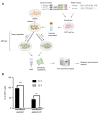Reduced Production of JAK2V617F-positive Microparticles at Mild Hypothermia
- PMID: 37369465
- PMCID: PMC10347929
- DOI: 10.21873/invivo.13254
Reduced Production of JAK2V617F-positive Microparticles at Mild Hypothermia
Abstract
Background/aim: The Philadelphia chromosome-negative (Ph-) myeloproliferative neoplasms (MPNs) are a group of blood cancers that arise from abnormal growth of blood cells in the bone marrow. Patients with MPNs are at increased risk for life-threatening thromboembolic complications. The detection of JAK2V617F in endothelial cells (ECs) brought a new perspective to the research of thromboembolic events. However, the mechanisms by which the mutation contributes to risk have yet to be entirely understood. Consequently, the objective of this study was to investigate how JAK2V617F impacts endothelial cells by considering thermoregulation.
Materials and methods: We applied our previously created model for EC that was genetically modified with JAK2 wild type (WT)-GFP and JAK2V617F-GFP lentiviruses; the cells were cultured for 48 h at 37°C for normothermia and 32°C for mild hypothermia. We examined the effect of thermoregulation on infection efficiency and the expression of cell surface markers, including endothelial protein C receptor (EPCR), thrombomodulin (TM), and tissue factor (TF), which are related to the coagulation pathways. Furthermore, the microparticle production from the genetically modified EC (EMPs) was analyzed.
Results: We found suppression of the expression of coagulation factors, including EPCR, TM, and TF in JAK2V617F positive ECs under mild hypothermia. JAK2V617F-positive ECs showed slightly higher EMP production under mild hypothermia.
Conclusion: Although the molecular mechanisms of the thermal effects on the tumor microenvironment with JAK2V617F and its effect on EMP production and coagulation are not known yet, the therapy-oriented effect of thermoregulation might be considered in future studies.
Keywords: JAK2V617F; endothelial cells; extracellular vesicles; hypothermia; microparticles; thrombosis.
Copyright © 2023, International Institute of Anticancer Research (Dr. George J. Delinasios), All rights reserved.
Conflict of interest statement
The Authors have no conflicts of interest to declare in relation to this study.
Figures



References
-
- James C, Ugo V, Le Couédic J, Staerk J, Delhommeau F, Lacout C, Garçon L, Raslova H, Berger R, Bennaceur-Griscelli A, Villeval J, Constantinescu S, Casadevall N, Vainchenker W. A unique clonal JAK2 mutation leading to constitutive signalling causes polycythaemia vera. Nature. 2023;434(7037):1144–1148. doi: 10.1038/nature03546. - DOI - PubMed
-
- Baxter E, Scott L, Campbell P, East C, Fourouclas N, Swanton S, Vassiliou G, Bench A, Boyd E, Curtin N, Scott M, Erber W, Green A. Acquired mutation of the tyrosine kinase JAK2 in human myeloproliferative disorders. The Lancet. 2020;365(9464):1054–1061. doi: 10.1016/S0140-6736(05)71142-9. - DOI - PubMed
-
- Levine R, Wadleigh M, Cools J, Ebert B, Wernig G, Huntly B, Boggon T, Wlodarska I, Clark J, Moore S, Adelsperger J, Koo S, Lee J, Gabriel S, Mercher T, D’Andrea A, Fröhling S, Döhner K, Marynen P, Vandenberghe P, Mesa R, Tefferi A, Griffin J, Eck M, Sellers W, Meyerson M, Golub T, Lee S, Gilliland D. Activating mutation in the tyrosine kinase JAK2 in polycythemia vera, essential thrombocythemia, and myeloid metaplasia with myelofibrosis. Cancer Cell. 2020;7(4):387–397. doi: 10.1016/j.ccr.2005.03.023. - DOI - PubMed
MeSH terms
Substances
Supplementary concepts
LinkOut - more resources
Full Text Sources
Medical
Miscellaneous
